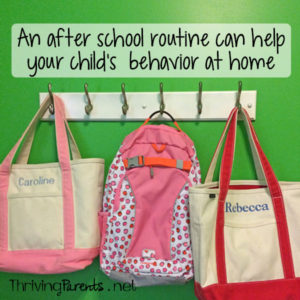
One of the questions I am asked most often as a parenting coach is, “Why do children behave so well at school and not at home?” This frustrates parents because they haven’t seen their kids all day and want to actually enjoy them. I think it’s especially hard on working parents because they need to fit household chores and cooking dinner into the small window that is shared with spending time with their children.
There are a lot of reasons that kids behave differently at home and school. Some of them include: the child had a bad day at school, they’re tired, hungry, they felt left out on the playground, they don’t feel well, they’re not feeling connected to the family, and on and on.
Typically, there tends to be 2 reasons that are at the root of this problem.
The first reason is that the child is “on” all day at school. They’re paying attention, learning, and absorbing all day long. I don’t need to tell you how little down time kids get at school now with cuts in art programs and shorter recesses. Home is (and should be) a safe place where kids can finally relax and decompress. Take it as a compliment that they feel you are their safe place.
The second reason is there is no schedule at home. Although kids need to decompress, they also need some structure. Kids thrive when they know what comes next and what’s expected of them. Every teacher has a schedule in her classroom where the kids can see exactly what time they are doing each activity and exactly what activities will follow. For smaller children in younger grades, this schedule will have pictures included with the words.
I recently worked with a family that was having behavior issues after school. The children (ages 10, 8, & 6) didn’t have any type of schedule because the parents thought the kids needed to relax, do homework, and have some time without a schedule. The mother was frustrated and willing to try anything. The sibling fighting was getting out of control and it was taking twice as long to get homework done. Homework was proving hard enough for the children anyway, as it often does for many kids. It’s no wonder that students make good use of services like edupeet when the workload they are stuck with at home is often too much and too challenging, especially when there are other problems within a household. Because this mother was refereeing arguments, dinner was getting later and later, which pushed bedtime later and later. You can see how this is a vicious circle, right?
With my suggestion, the family implemented an after school schedule. It looked something like this:
We wanted to incorporate any tasks that would need to be done so that the children would be able to locate them somewhere on the schedule. The schedule is also very loose. This means that if they want to play outside longer, they can. The schedule is just a good place to revert back to when the kids need to be centered.
The father emailed me the first night of the schedule and said that the kids LOVED it. They responded to it immediately and referred to it when it looked like dinner might be late (it wasn’t!). Many times throughout the afternoon and evening one or more of the kids would look at the schedule to see what was coming next.
A month and a half later, I followed up with the mother and she was raving about how great the schedule was still working. The kids were used to the routine now and weren’t physically going up to the schedule to look at it as much, but they were all still holding each other accountable for following it. The children were getting along better and were getting their homework done in less time.
How do you make an after school schedule?
Start by making a list of all the things that need to get done after school and up until bedtime. Estimate how long each activity will take. It’s even a great idea to make the schedule WITH the kids. Their inclusion will make them feel valuable and they’re more apt to cooperate if they know you value their input. You can always change the schedule around as the days go by. Let the children know that you all will need to work on it together to find a schedule that works for everyone. Your family is a team. For example, if you want the kids to do their homework in the kitchen while you are making dinner, schedule their homework time for right before dinner. Also, if you have any non or early readers, include pictures on your schedule. You can have the kids draw them, print them out from the internet, take actual photos, or use ClipArt.
If you’d like a blank version of the one above so you can add your own family’s steps, you can DOWNLOAD it HERE.
The schedule isn’t meant to be rigid or replace downtime. As a matter of fact, make sure that you incorporate down time! The schedule provides some familiarity and consistency for the kids that need it.
Do you use a schedule in your house? What kind of things do you have a schedule for?
xoxo
–k
Pin to save this for later!






This is great Kristina! You nailed it here! My kids have expectations every day after school, but each kid is different, so Cass goes straight to her homework after unpacking her backpack and lunch and telling me about her day- and Cade has 'down time playing a video game' after he shows me his school work and unpacks his backpack and lunch. Schedules and expectations and structure is necessary for us all!
Great idea!!
My son does really well with schedules and I love this!
This is the answer to all my problems right now!!! THANK YOU!!!
Love it! We have been doing a bedtime High Five with my 6 year olds and 3 year old–(1. Bath 2. Dinner 3. Electronics 4. Snack and Teeth 5. Books/Legos/Card Games/Snuggles/Chat time as a family upstairs. Even my youngest talks about the steps and loves giving a high five when he finishes the evening routine successfully. As you suggested when we talked, the key is getting them upstairs at a very early hour for the calm family time.